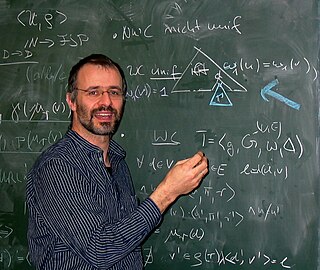
An emoticon, short for emotion icon, is a pictorial representation of a facial expression using characters—usually punctuation marks, numbers, and letters—to express a person's feelings, mood, or reaction, without needing to describe it in detail.

Carnegie Mellon University (CMU) is a private research university in Pittsburgh, Pennsylvania. The institution was established in 1900 by Andrew Carnegie as the Carnegie Technical Schools. In 1912, it became the Carnegie Institute of Technology and began granting four-year degrees. In 1967, it became Carnegie Mellon University through its merger with the Mellon Institute of Industrial Research, founded in 1913 by Andrew Mellon and Richard B. Mellon and formerly a part of the University of Pittsburgh.
Kent M. Pitman (KMP) is a programmer who has been involved for many years in the design, implementation, and use of systems based on the programming languages Lisp and Scheme. Since 2010, he has been President of HyperMeta, Inc.

The School of Computer Science (SCS) at Carnegie Mellon University in Pittsburgh, Pennsylvania, US is a school for computer science established in 1988. It has been consistently ranked among the top computer science programs over the decades. As of 2022 U.S. News & World Report ranks the graduate program as tied for second with Stanford University and University of California, Berkeley. It is ranked second in the United States on Computer Science Open Rankings, which combines scores from multiple independent rankings.

Dabbala Rajagopal "Raj" Reddy is an Indian-American computer scientist and a winner of the Turing Award. He is one of the early pioneers of artificial intelligence and has served on the faculty of Stanford and Carnegie Mellon for over 50 years. He was the founding director of the Robotics Institute at Carnegie Mellon University. He was instrumental in helping to create Rajiv Gandhi University of Knowledge Technologies in India, to cater to the educational needs of the low-income, gifted, rural youth. He was the founding chairman of International Institute of Information Technology, Hyderabad. He is the first person of Asian origin to receive the Turing Award, in 1994, known as the Nobel Prize of Computer Science, for his work in the field of artificial intelligence.

David S. Touretzky is a research professor in the Computer Science Department and the Center for the Neural Basis of Cognition at Carnegie Mellon University. He received a BA in Computer Science at Rutgers University in 1978, and earned a master's degree and a Ph.D. (1984) in Computer Science at Carnegie Mellon University. Touretzky has worked as an Internet activist in favor of freedom of speech, especially what he perceives as abuse of the legal system by government and private authorities. He is a notable critic of Scientology.
*Lisp is a programming language, a dialect of the language Lisp. It was conceived of in 1985 by two employees of the Thinking Machines Corporation, Cliff Lasser and Steve Omohundro, as a way to provide an efficient yet high-level language for programming the nascent Connection Machine (CM).

Sebastian Thrun is a German-American entrepreneur, educator, and computer scientist. He is CEO of Kitty Hawk Corporation, and chairman and co-founder of Udacity. Before that, he was a Google VP and Fellow, a Professor of Computer Science at Stanford University, and before that at Carnegie Mellon University. At Google, he founded Google X and Google's self-driving car team. He is also an adjunct professor at Stanford University and at Georgia Tech.
Alexander G. Hauptmann is an American academic. He currently serves as a research professor in the Language Technologies Institute at the School of Computer Science at Carnegie Mellon University. He has been the leader of the Informedia Digital Library, which has made seminal strides in multimedia information retrieval and won best-paper awards at major conferences. He was also a founder of the international advisory committee for the Text Retrieval Conference Video Retrieval Evaluation, also known as TRECVID.
John E. Laird is a computer scientist who, created the Soar cognitive architecture at Carnegie Mellon University with Paul Rosenbloom and Allen Newell. Laird is a professor in the Computer Science and Engineering Division of the Electrical Engineering and Computer Science Department of the University of Michigan.

The Language Technologies Institute (LTI) is a research institute at Carnegie Mellon University in Pittsburgh, Pennsylvania, United States, and focuses on the area of language technologies. The institute is home to 33 faculty with the primary scholarly research of the institute focused on machine translation, speech recognition, speech synthesis, information retrieval, parsing, information extraction, and multimodal machine learning. Until 1996, the institute existed as the Center for Machine Translation, which was established in 1986. Subsequently, from 1996 onwards, it started awarding degrees, and the name was changed to The Language Technologies Institute. The institute was founded by Professor Jaime Carbonell, who served as director until his death in February 2020. He was followed by Jamie Callan, and then Carolyn Rosé, as interim directors. In August 2023, Mona Diab became the director of the institute.

Jaime Guillermo Carbonell was a computer scientist who made seminal contributions to the development of natural language processing tools and technologies. His extensive research in machine translation resulted in the development of several state-of-the-art language translation and artificial intelligence systems. He earned his B.S. degrees in Physics and in Mathematics from MIT in 1975 and did his Ph.D. under Dr. Roger Schank at Yale University in 1979. He joined Carnegie Mellon University as an assistant professor of computer science in 1979 and lived in Pittsburgh from then. He was affiliated with the Language Technologies Institute, Computer Science Department, Machine Learning Department, and Computational Biology Department at Carnegie Mellon.

Michael Kohlhase is a German computer scientist and professor at University of Erlangen–Nuremberg, where he is head of the KWARC research group.

Manuela Maria Veloso is the Head of J.P. Morgan AI Research & Herbert A. Simon University Professor Emeritus in the School of Computer Science at Carnegie Mellon University, where she was previously Head of the Machine Learning Department. She served as president of Association for the Advancement of Artificial Intelligence (AAAI) until 2014, and the co-founder and a Past President of the RoboCup Federation. She is a fellow of AAAI, Institute of Electrical and Electronics Engineers (IEEE), American Association for the Advancement of Science (AAAS), and Association for Computing Machinery (ACM). She is an international expert in artificial intelligence and robotics.
Peter Lee is an American computer scientist. He is Corporate Vice President and head of Microsoft Research. Previously, he was the head of the Transformational Convergence Technology Office of the Defense Advanced Research Projects Agency and the chair of the Computer Science Department at Carnegie Mellon University. His research focuses on software security and reliability.

Eric Poe Xing is an American computer scientist whose research spans machine learning, computational biology, and statistical methodology. Xing is founding President of the world’s first artificial intelligence university, Mohamed bin Zayed University of Artificial Intelligence (MBZUAI).
Yolanda Gil is a Spanish computer scientist specializing in knowledge discovery and knowledge-based systems at the University of Southern California (USC). She served as chair of SIGAI the Association for Computing Machinery (ACM) Special Interest Group (SIG) on Artificial Intelligence, and the president of the Association for the Advancement of Artificial Intelligence (AAAI).
Roni Rosenfeld is an Israeli-American computer scientist and computational epidemiologist, currently serving as the head of the Machine Learning Department at Carnegie Mellon University. He is an international expert in machine learning, infectious disease forecasting, statistical language modeling and artificial intelligence.

Hideto Tomabechi is a Japanese cognitive scientist computer scientist.

Carnegie Mellon University Africa, in Kigali, Rwanda, is a global location of Carnegie Mellon University. CMU-Africa offers master's degrees in Information Technology, Electrical and Computer Engineering, and Engineering Artificial Intelligence. CMU-Africa is part of the Carnegie Mellon College of Engineering. The College of Engineering is top-ranked. In U.S. News & World Report's 2024 graduate rankings, the College of Engineering was ranked #5.












